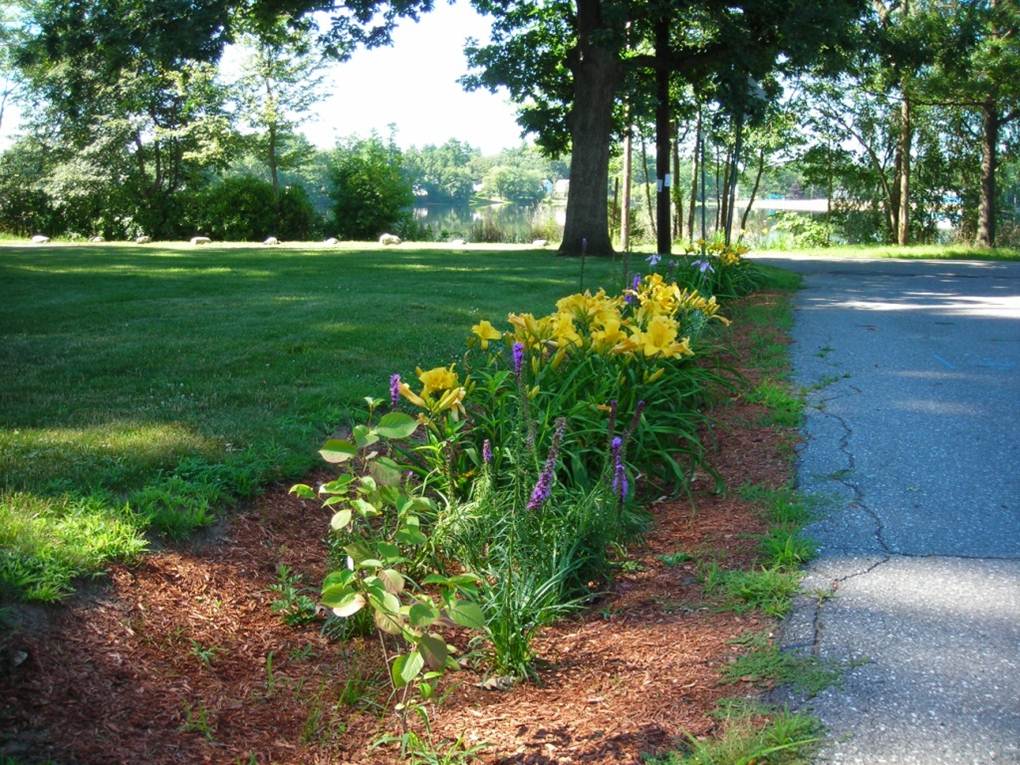Lawn/Landscaping Education

Description
This management measure seeks to control the storm water impacts of landscaping and lawn care practices through education and outreach on methods that reduce nutrient loadings and the amount of storm water runoff generated from lawns. Nutrient loads generated by fertilizer use on suburban lawns as well as municipal properties can be significant, and recent research has shown that lawns produce more surface runoff than previously thought (CWP 1999).
Applicability
This practice is widely applicable for urban and commercial areas, as well as agricultural areas. Homeowners, lawn care companies and farmers should be informed of the impacts of over-fertilization and pesticides. Integrated Pest Management (IPM) and reduced fertilizer application are practices that should be communicated to these audiences through educa- tional programs. Informing audiences on methods to reduce fertilizer and pesticide application, limit water use, and avoid land disturbance can help alleviate the potential impacts of a major contributor of nonpoint source pollution in residential communities.
Effectiveness
Source area monitoring in Marquette, Michigan, found that nitrogen and phosphorus concentrations in residential lawn runoff were 5 to 10 times higher than from any other source area (CWP 1999). However, the effectiveness of pollution prevention programs designed to educate residents on lawn care and landscaping practices has not been well documented to date.
Media campaigns and intensive training can each produce a 10 to 20-percent improvement in selected watershed behaviors among their respective target populations. A combination of both outreach techniques is probably needed in most watersheds, as each complements the other. Media campaigns are generally better at increasing awareness and sending mes- sages about negative watershed behaviors. Intensive training, on the other hand, is superior at changing individual practices in the home, lawn, and garden.
Using proper landscaping techniques can effectively increase the value of a property while benefiting the environment. Attractive, water-efficient, low maintenance landscapes can increase property values between 7 and 14 percent (USEPA 1993). These practices also benefit the environment by reducing water use; decreasing energy use (because less water pumping and treatment is required); minimizing runoff of storm and irrigation water that transports soils, fertilizers, and pesticides; and creating additional habitat for plants and wildlife.
Cost
The cost of creating and maintaining a program that addresses lawn care, landscaping practices and water quality varies depending on the intensity of the effort and the outreach techniques selected. Media campaigns often require a greater amount of money to create, but are also most likely to reach the largest proportion of the community. Intensive training campaigns may not require as large a creation cost, but often require more staff time. Production costs for materials such as flyers and brochures are often inexpensive ($0.10 to $0.50 per brochure), and soil kits and testing may be provided through a local university to reduce expense. Many watershed organizations and government agencies have already produced materials on lawn care and landscaping techniques to protect water quality, and program managers may save money by using or adapting these available resources. Some of these resources are included with this fact sheet (see "Recommended Fact Sheets and Resources").
Recommended Fact Sheets and Resources
FLDEP. 2001. Waterfront Property Owners Guide. Florida Department of Environmental Protection, Tallahasee, Fl.
http://www.dep.state.fl.us/water/stormwater/npdes/index.htm
Lawn Care Near Lakes. University of Maine Cooperative Extension. Accessed 7/16/02.
http://www.umaine.edu/waterquality/
UWEX. 2000. Yard Care and the Environment: Water Quality Fact Sheets for Residential Areas. University of Wisconsin-Extension Water Resources Programs. Accessed 7/19/02.
http://clean-water.uwex.edu/pubs/yardcare/index.html.
References
Berkshire County Regional Planning Commission. 2003. The Massachusetts Buffer Manual. Using Vegetated Buffers to Protect our Lakes and Rivers.
Center for Watershed Protection (CWP). 1999. On Watershed Behavior.
http://www.cwp.org . Lehner, P., G. P. Aponte Clark, D. M. Cameron and A. G. Frank. 1999. Stormwater strategies: community responses to runoff pollution. National Resource Defense Council,
http://www.nrdc.org/water/pollution/storm/stoinx.asp
Massachusetts Executive Office of Environmental Affairs. More Than Just A Yard. Ecological Landscaping Tools for Massachusetts Homeowners.
Schueler, T. "Pollution Prevention Fact Sheet: Landscaping and Lawn Care." Stormwater Manager’s Resource Center. Center for Watershed Protection, Inc. Accessed 3/7/2002.
http://www.stormwatercenter.net.
USEPA. 1993. Xeriscape Landscaping: Preventing Pollution and Using Resources Efficiently. EPA/840/B-93/001. U.S. Environmental Protection Agency, Office of Water, Washington, DC. USEPA. 2002. National Menu of Best Management Practices for Storm Water Phase II. Accessed 3/7/2002.
http://www.epa.gov/npdes/menuofbmps/menu.htm.